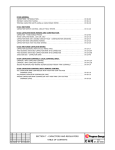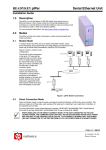Download Cinelabs HV-2000 Flyback Installation Guide for the Wells
Transcript
Cinelabs HV-2000 Flyback Installation Guide for the Wells-Gardner K6100 WARNING: CRT display monitors can produce lethal voltages. Refer servicing to qualified service personnel. PLEASE NOTE: This product is intended to be installed following the guidelines contained in this document, by qualified service personnel. The manufacturer and distributors of this product will not be held liable for any damage resulting from this product’s use. If you are uncomfortable with this, you may return the product within seven (7) days, for a full refund. Revision 1.0 June 3, 2007 Revision 1.0 : RELEASED 6/18/2007 Page 2 of 11 If properly installed by a qualified service person, this product will be warranted for a period of one year. This period starts on the date of receipt of product, if ordered directly from Cinelabs, or, from the purchase date on the original receipt, if purchased through an authorized distributor. Should you ever have to use this warranty, the distributor you purchased your Flyback from will repair or replace, at their option, the original part. The distributor’s and Cinelabs’ liability is limited to replacement of the part, and neither party will be responsible for any damages incidental or consequential to your game or person. This warranty does not cover “abuse” (physical, environmental, or electrical), and is only valid for parts installed in a genuine WellsGardner High-Voltage unit. Please contact Cinelabs in advance, regarding warranty terms for components used in third party/aftermarket HV Boards. Please note, the warranty is void if the Cinelabs sticker is removed. Terms: By installing this part, you agree to take full responsibility for any damage caused to your game and/or person, you may incur, due to lack of experience or expertise, lack of having the correct tools, etc. You agree to read the complete installation manual, prior to installing the part, and complying with all safety advisements and warnings. Revision History: Rev. 0.1 0.2 0.4 0.5 Date 12/10/2006 12/14/2006 12/18/2006 1/22/2007 Author Shostak Shostak Shostak Shostak 1.0 6/03/2007 Shostak Comments Initial Draft Major Editing Incorporated Review Feedback Added revision history, Warranty, T&Cs, comments and corrections note, and latest revision link Formal Release The most recent revision of this document can be found at: http://www.cinelabs.com/docs/WG_Install.pdf Please send corrections or comments to: [email protected] This guide is intended to assist in the replacement of the Flyback Transformer (“FBT”) of WellsGardner 6100 and 6400 series color X-Y Vector monitors, when it has been determined the FBT is defective. This guide is not intended to explain how to troubleshoot or diagnose these monitors. Use the original Wells-Gardner monitor service manual for information on troubleshooting, parts replacement and proper adjustment and alignment of the monitor. Copyright © 2006 Cinelabs, LLC www.cinelabs.com Revision 1.0 : RELEASED 6/18/2007 Page 3 of 11 Be sure to perform the high-voltage adjustment and if you are using a P329 HV PCB, perform the high-voltage shutdown adjustment. Be sure to read this entire document *before* working on your 6100 monitor. CRT displays are dangerous and potentially lethal. There is risk of physical injury from the glass CRT and danger of electrocution from high-voltage. We advise always wearing safety glasses when working on CRT displays, as well as keeping one hand behind your back when working on a CRT display, energized or not. Remember, CRT picture tubes can store a High-Voltage charge for extended periods of time. Always be sure to discharge the CRT prior to FBT replacement and follow ALL industry safety practices and procedures, regardless of how long the display has been turned off. Never make any assumptions. Be sure to perform the high-voltage adjustment and perform the high-voltage safety shutdown adjustment. If you are unsure of how to perform any safety related procedures, or are unsure of how to safely perform this procedure, please contact a trained service technician to perform the installation or return the never installed FBT, for a full refund. Please note, there is a factory connection point on the top of the Flyback. This terminal is only for factory use, and is to remain disconnected during normal operation. Copyright © 2006 Cinelabs, LLC www.cinelabs.com Revision 1.0 : RELEASED 6/18/2007 Page 4 of 11 Helpful Hints: The HV-2000 flyback kit can optionally be shipped with an “enhancement” kit, intended to help protect the WG high voltage unit from more extensive damage in the event of a failure of a critical component. See page 9 for more information. Over years of servicing the Wells-Gardner 6100, one issue has come up time and time again. This issue is the installation of incorrect parts, frequently resistors and Zener diodes, during previous repairs. This often results in subtle problems such as poor regulation, low voltage output, or excessively high high-voltage output. Always use the correct parts, and be on the lookout for “artifacts” of creative repairs. The typical high-voltage output range for the Wells-Gardner 6100 HV Cage is roughly 15,000V to 22,000V. Flyback Transformers are capable of producing significantly more voltage. Therefore, if your notice your HV Cage is generating over 24,000V, it may be indicative of a regulation problem. At least one HV Cage has been encountered by Cinelabs which was producing in excess of 27,000V. This problem was ultimately traced to resistors of the wrong value having been installed in the regulator circuit during a previous repair. On principle, after repairing the WG HV Cage, be sure to perform the highvoltage adjustment. If you are using a P329 HV PCB, perform the high-voltage shutdown adjustment. This applies whether or not the FBT has been replaced. If at any point you experience a no high-voltage condition after installing this upgrade, always remember to check the fuses. A “cap kit” can help eliminate some problems with the HV Cage. In addition, a well respected RGVAC member recommends using 470uF High-Frequency caps in place of the original C901 and C902, as well as using a 7 watt wire-wound resistor in place of R901. We pass this information along as a courtesy, but have not tried it. The “Wells-Gardner 6100 Color Vector Monitor FAQ” is a good source of background information, as well as specific information on troubleshooting the WG HV unit. Copies are available across the internet, at sites such as Ionpool: http://ionpool.net/arcade/tech/6100_faq.pdf For further information on trouble-shooting the Wells-Gardner Color Vector monitor, the reader is directed to the Usenet group Rec.Games.Video.Arcade.Collecting, and to the Vectorlist archives, which are located at http://www.vectorlist.org. Cinelabs is a proud sponsor of the Vectorlist. :-) Copyright © 2006 Cinelabs, LLC www.cinelabs.com Revision 1.0 : RELEASED 6/18/2007 Page 5 of 11 HV Cage Removal: 1. Determine FBT is defective. 2. Discharge any residual energy from the CRT, following industry standard CRT discharge procedures. 3. Disconnect the FBT anode cap from the CRT, following industry standard procedures (we recommend, at minimum, keeping one hand behind your back). 4. Momentarily short the anode cap to the chassis, to ensure the FBT is discharged. 5. Disconnect Focus and Screen connector (3 pin Amp connector) from HV unit. 6. Disconnect power connector (8 position red Molex connector) from HV unit. 7. Remove screws. 8. Remove HV Cage from monitor. Flyback Replacement: 1. 2. 3. 4. Disconnect and remove the Focus Assembly from the HV Cage. Be sure to save the plastic insulator, as this part will be reused. Unsolder and remove the original FBT from the HV Cage. Remove the original plastic grommet from the high-voltage wire between the Flyback and Focus Assembly, as this part will be reused. 5. On the back side of the new Focus Assembly, carefully remove the two plastic alignment tabs. DO NOT CUT/REMOVE ANY METAL. We’ve found an X-Acto knife works very well. Figure 1: Plastic Alignment Tabs Note: Failure to remove the plastic alignment tabs in step 5 will prevent the Focus Assembly from lying as closely as possible against the back of the HV Cage. Copyright © 2006 Cinelabs, LLC www.cinelabs.com Revision 1.0 : RELEASED 6/18/2007 Page 6 of 11 6. If installing in a P329 HV Cage, read additional P329 steps NOW (see page 7). 7. Install and solder the new replacement Flyback transformer in the HV Cage. Note: To make it easier to adjust the pins on the new FBT, it can be temporarily installed from the bottom of the PCB, as an alignment guide. Once the pins are properly aligned with the holes in the PCB, install the FBT from the top of the PCB and solder in place. 8. Solder the ground wire to the ground lug on the Focus Assembly (same lug as on the original Focus Assembly). 9. Attach the Focus Assembly to the HV Cage using the original screws and nuts, being sure to install the plastic insulator removed from the original Focus Assembly. Do not tighten the nuts at this time. 10. Attach the Focus and Screen wires to the Focus Assembly, being sure the connectors and boots are fully seated. 11. Tighten the Focus Assembly screws and nuts. Note: The ground lug can contact the metal chassis, provided this is NOT a P329 HV Cage (with HV Shutdown adjustment). For P329 installation, see additional steps on page 7. 12. Install the grommet removed in step 4, on the red HV wire between the new Flyback and the Focus Assembly. Then press the grommet into the HV Cage (where it was originally removed from). 13. Reassemble monitor in reverse order of disassembly. Did you install the plastic insulator behind the Focus Assembly? We recommend installing the additional HV protection detailed on page 9. HV Adjustment: The following adjustment should be performed with no video signal applied to the monitor. DO NOT attempt to adjust the HV using the Video B+ supply as a reference, as many factors influence this voltage, and it will most likely result in a significant HV error. 1. With power OFF 2. Center the High Voltage control pot (R918). 3. Connect a high-voltage probe to the monitor (following the probe’s manufactures’ instructions). 4. Apply power to monitor and allow it to warm up for at least 15 minutes. 5. Adjust the HV output control pot (R918) for a reading of 19.5KV. 6. Inject a video signal into the monitor. 7. Adjust the Screen and Focus controls to taste. Copyright © 2006 Cinelabs, LLC www.cinelabs.com Revision 1.0 : RELEASED 6/18/2007 Page 7 of 11 P329 Specific Installation Steps: These additional steps must be followed to ensure proper operation of the HV shutdown circuit: 1. Check Focus Assembly ground lug to ensure it is not contacting the HV Cage (i.e. shorted to ground). 2. If required, elongate the screw holes in the Focus Assembly (and insulator), which will allow you to shift it slightly upwards, and ensure there are no shorts. GOOD: No Shorts to Chassis BAD: FA Shorted to Chassis P329 HV Shutdown Adjustment: If your HV board is a P329 (WG part number 85X0155), you must adjust the HV Shutdown set point, for proper operation. We recommend setting the shutdown adjustment to a conservative 23KV. This procedure assumes the HV Cage is properly assembled and working correctly. 1. Set the HV Trip adjustment (R930) fully counter-clockwise (see Figure 2). 2. Adjust the HV output control (R918) to 23KV1. 3. Rotate the HV Trip adjustment (R930) clockwise, until the HV shuts down, and the LED illuminates. 4. If you rotate R930 fully clockwise and the unit has not shutdown, you have fault in the HV cage which needs to be corrected before this procedure can be completed and the unit returned to normal operation. 5. Center the HV output control (R918) (NOT the Trip adjustment), and perform the regular 19.5KV HV adjustment. Note1 – Not all HV Cages will produce 23KV. In this case, adjust the unit to shutdown at maximum HV output. Copyright © 2006 Cinelabs, LLC www.cinelabs.com Revision 1.0 : RELEASED 6/18/2007 Page 8 of 11 Figure 2: R930 HV Trip Adjustment Copyright © 2006 Cinelabs, LLC www.cinelabs.com Revision 1.0 : RELEASED 6/18/2007 Page 9 of 11 Background on WG Over-Current Protection Components: Over the course of the development of the new HV-2000, many failed HV cages were repaired for use in the project. Frequently, they were charred to a crisp (see figure 3). Additionally, during one of the early Alpha tests, the 25 cent NE555 timer chip failed (unrelated to the new FBT :-), resulting in damage to the output transformer (see figure(s) 4), and rendering the board useless. At that point, it became clear that the over-current protection in the 6100 was insufficient to protect the HV Cage. Figure 3: Figure(s) 4: This enhancement adds a simple over-current protection mechanism to the WG6100 HV Cage. Specifically, a 630ma slow-blow fuse is installed in both the positive and negative power supply rails and a 250ma PICO®II fuse is installed in the current source for the drive transformer, T901. Disclaimer: This enhancement will help protect the HV Cage, but problems can and will still occur. The intent here is to attempt to limit the damage, when a problem does occur. These parts will be provided with the HV-2000, while supplies last. If you did not receive these parts, you can obtain them from your “local” electronics parts supplier. While this protection circuit provides protection on the new FBT, it also provides protection for your step down transformer, T901, which is otherwise unprotected and actually quite vulnerable. The over-current protection is recommended, but not required. If the protection is not added, the HV Cage will merely continue to operate as it has for the last 25+ years. This enhancement can also be added to HV Cages with an original WG FBT installed, to help protect those units as well. Installing Enhanced Protection Components: 1. Unsolder and lift one leg of the following resistors from the HV PCB: R901 R907 R917 Copyright © 2006 Cinelabs, LLC www.cinelabs.com Revision 1.0 : RELEASED 6/18/2007 Page 10 of 11 2. Solder one leg of one of the provided slow-blow fuses into the vacated hole of R901. 3. Solder the other leg of the slow-blow fuse to the raised leg of R901, “Tee-Pee” style. 4. Solder one leg of the remaining slow-blow fuse into the vacated hole of R907. 5. Solder the other leg of the slow-blow fuse to the raised leg of R907, “Tee-Pee” style. Figure 3: R901 and R907 in “Tee-Pee” Configuration 6. Solder one leg of the green PICO® fuse into the vacated hole of R917. 7. Solder the other leg of the green PICO® fuse to the raised leg of R917, “Tee-Pee” style. Figure 4: R917 in “Tee-Pee” Configuration 8. End of procedure. Congratulations. FBT Installation is complete! Copyright © 2006 Cinelabs, LLC www.cinelabs.com Revision 1.0 : RELEASED 6/18/2007 Page 11 of 11 Wells-Gardner K6100 High-Voltage Unit Schematic Copyright © 2006 Cinelabs, LLC www.cinelabs.com




















